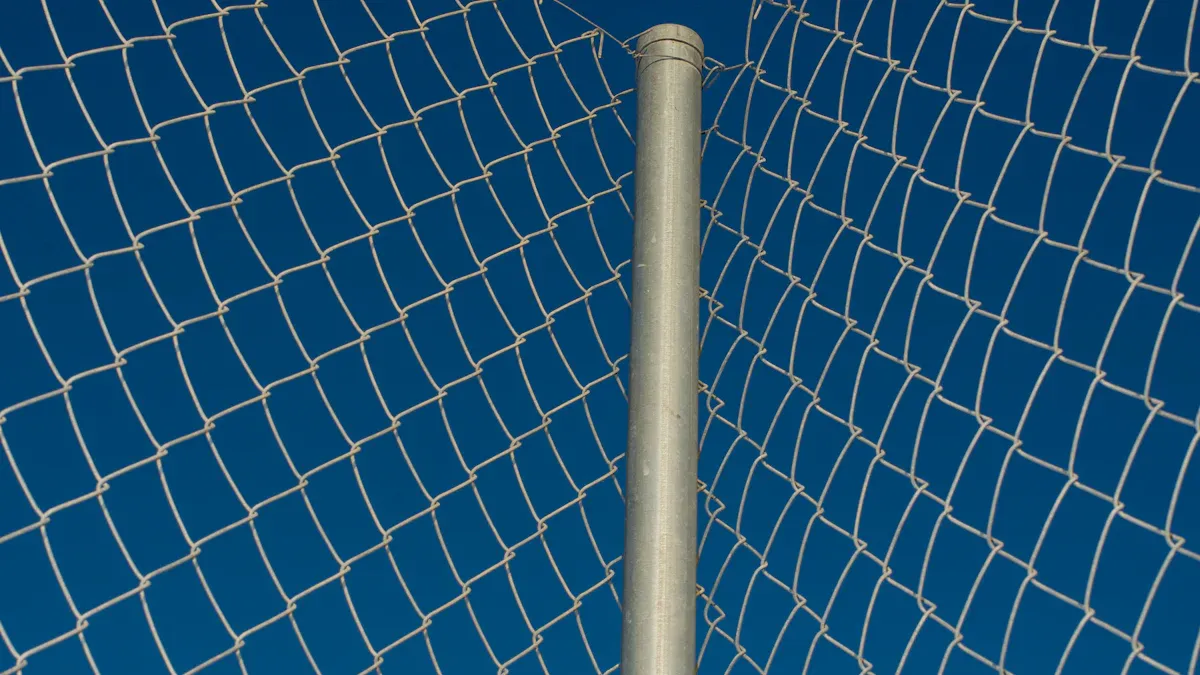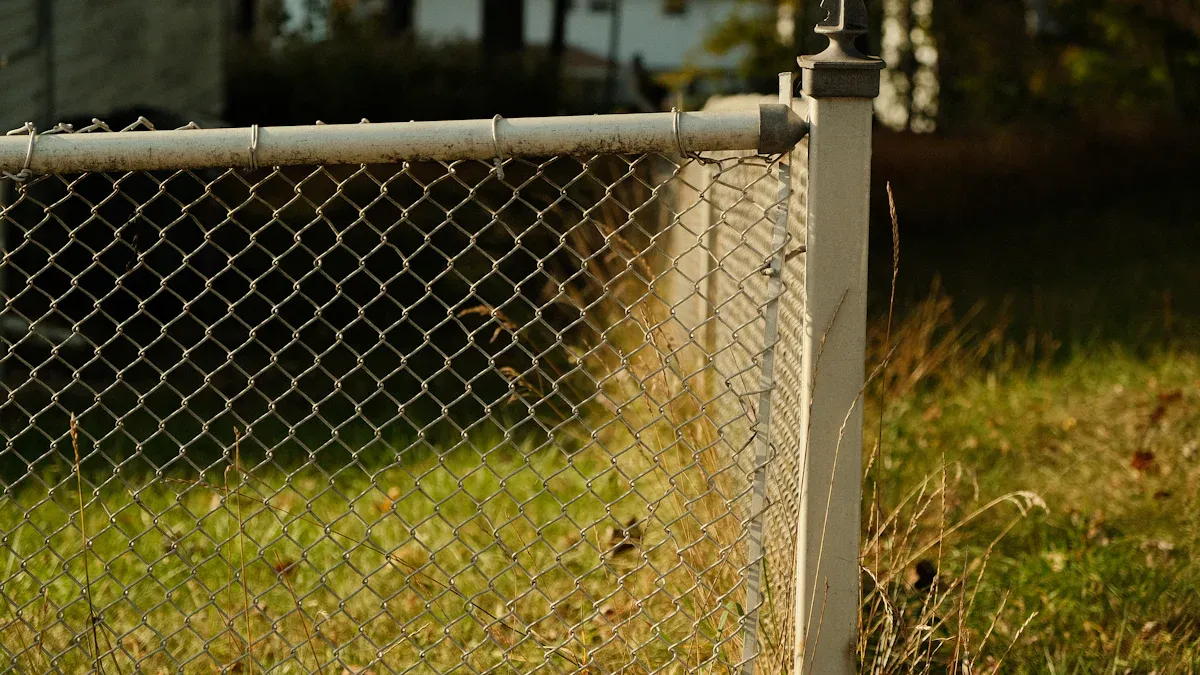Outdoor Storage
Views: 0 Author: Site Editor Publish Time: 2025-09-12 Origin: Site









A chain link fence uses a woven wire-mesh design made from steel. Many people call it a chain-link fence. Builders often choose this type of fence for homes, schools, and businesses because it works in many places and lasts a long time.
Chain link fences do not cost much and are strong. They can last 15 to 30 years if you take care of them. You do not need to do much to keep them nice. Just clean them sometimes and check for rust. This helps them stay in good shape. Chain link fences can be used in many places. People use them at homes, businesses, and parks. They help keep people safe and you can see through them.

Image Source: pexels
A chain-link fence is also called a cyclone fence or hurricane fence. Some people call it a wire-mesh fence or diamond-mesh fence. It uses metal wires woven in a pattern. The main part is made from chain link fabric. The wires twist together to make diamond shapes. This creates a strong mesh. Air and light can move through the fence. The fence keeps people and animals in or out.
The most common materials for chain-link fences are:
Galvanized steel: This material does not rust easily. It costs less than other materials. Many people pick galvanized chain link fences because they last a long time.
Vinyl-coated steel: This type has a colored layer for extra protection. The coating makes the fence stronger and looks better. Polyethylene-coated chain link fences protect even more from bad weather. The coating stops rust and corrosion. This helps the fence last longer outside.
Stainless steel: This material is very strong and lasts a long time. Factories and big sites use stainless steel chain link fabric. It costs more than other types.
Aluminum: This metal is light and works well near the ocean. Aluminum chain-link fencing is good for the environment. It does not rust.
Other materials: Some new chain link fabrics use special mixes for unique needs.
Chain-link fences use posts made from steel or aluminum. Workers put these posts in concrete to keep them steady. The chain link fabric connects to the posts with ties or clips. Gates use the same materials and design as the fence.
Note: Making and throwing away chain-link fencing can hurt the environment. Factories release greenhouse gases. It is hard to recycle the twisted wires. If not thrown away right, it can harm nature nearby.
Chain-link fences are practical and save money. Many people use them for homes, schools, and businesses. They work well and cost less than wood or wrought iron. Chain link fabric does not need much care. Owners just clean it and check for rust sometimes.
Chain-link fences are strong and last a long time. Galvanized chain link fences can last 15 to 25 years in normal weather. Good quality fences can last 30 years or more if cared for. Polyethylene-coated chain link fences last even longer and look good over time.
Chain-link fences work well in bad weather. The open design lets air move through. This helps the fence stay up in strong winds and heavy snow. Galvanized steel does not rust easily. But bad weather can still cause problems if not cared for.
You can see through chain link fabric. This helps security teams and cameras watch the area. There are no hidden spots. The open design also stops intruders because they know people can see them.
The table below shows how chain-link fencing compares to other types:
| Feature | Chain Link Fencing | Other Fencing Types |
|---|---|---|
| Cost | More affordable | Generally more expensive |
| Maintenance | Low maintenance | Higher maintenance (e.g., wood needs painting) |
| Durability | Highly durable | Varies (wood can rot, wrought iron needs rust prevention) |
| Appearance | Industrial look | More aesthetic options (e.g., wood, vinyl) |
| Security | Easier to climb | Harder to climb (e.g., wrought iron) |
Main features of chain-link fences are:
Costs less than wood and vinyl.
Needs little care, just clean sometimes.
Strong and stands up to weather, especially with galvanized chain link fabric.
Works for many places like homes, schools, and businesses.
Lets you see through for safety and watching.

Image Source: unsplash
Chain-link fencing is used in many places. People put it around homes, businesses, parks, and building sites. This fence works for both short-term and long-term needs. The next parts show the most common ways people use chain link fencing.
Many homeowners use a chain link fence for their yards. It makes a strong barrier to keep pets and kids safe. Families use these fences for dog runs and chicken coops. The open mesh lets adults watch kids as they play.
Chain-link fencing also shows where one yard ends and another begins. Some people add slats or screens for more privacy. This fence can handle bad weather and does not need much care. That is why many people pick it for their homes.
Tip: Chain-link fences are good for gardens and pools. They help keep out people who should not be there.
Businesses use chain link fencing to keep their property safe. About 25% of business places use this fence for security. Owners like it because it costs less and lasts a long time.
Some businesses add extra security to their fences. They might put barbed wire or razor wire on top. They can make the fence taller or use thicker wire. For example, a warehouse may use a tall fence with barbed wire to stop people from getting in. These changes make the fence harder to climb and safer.
Chain-link fencing also helps control who can get into parking lots and storage areas. It marks where people can and cannot go. Businesses use these fences for short jobs, like building projects or events.
Common business uses:
Protecting buildings and equipment
Keeping parking lots and storage safe
Making safe work areas
Stopping people from breaking in
You can find chain link fencing in parks and sports fields. Schools and cities use it to keep kids safe and control who enters. The open mesh lets coaches and parents see what is happening.
| Application | Description |
|---|---|
| Pickleball Court Fencing | Makes clear borders and keeps balls inside the court. |
| Baseball/Softball Field | Stops foul balls and keeps players and fans safe. |
| Playground Fencing | Keeps kids safe, controls entry, and lets adults watch. |
Temporary chain link fence panels are used at building sites and events. Workers put up these fences fast to make safe areas and control crowds. These fences protect equipment and workers from accidents. Event planners use them to guide people and manage entry.
Temporary chain link fencing has many benefits:
Gives good security for short times
Stays strong in bad weather
Works on many types of ground
Easy to put up and take down
Saves money for short projects
People use temporary chain link fencing for building sites, events, animal pens, and even homes or businesses. The fence keeps people and workers safe and helps follow rules. Organizers can move the fence panels when they need to change the setup.
Note: Chain-link fencing can be used for both short and long-term needs. This makes it a very flexible choice for property owners.
Chain-link fencing gives many good things to property owners. It saves money, needs little care, and keeps places safe. The table below shows how chain-link fencing compares to other types:
| Benefit | Chain Link Fencing | Wood Fencing | Vinyl Fencing | Wrought Iron Fencing |
|---|---|---|---|---|
| Cost-effectiveness | Yes | No | No | No |
| Low maintenance | Yes | No | No | No |
| Durability | Yes | No | No | Yes |
| Longevity | Yes | No | No | Yes |
| Enhanced security | Yes | No | No | Yes |
| Improved visibility | Yes | No | No | No |
| Eco-friendliness | Yes | No | No | No |
Chain-link fences use galvanized steel that stands up to bad weather. With good care, they can last more than 50 years. Chain-link does not break or split like wood. This makes it great for busy places. Owners just need to wash the fence sometimes to keep it nice.
Putting up a chain-link fence takes a few days for most homes. Workers set posts, put up panels, and add gates. Most jobs finish fast, but big or tricky fences take longer. Here are the steps for putting up a chain-link fence:
Mark where the fence will go and check the rules.
Dig holes and put posts in concrete.
Attach rails and pull the chain-link fabric tight.
Fasten the fabric and put in gates.
Tip: Good planning and putting posts in the right spot stop the fence from sagging. Always check the rules for fence height and how far it must be from the edge before you start.
Some problems are digging deep holes, pulling the wire tight, and keeping posts straight. Using good materials, like vinyl-coated chain link, stops rust and helps the fence last longer.
Chain-link fencing can be changed to fit what people want. Owners can pick different colors, heights, and ways to get more privacy. The table below shows some choices:
| Feature | Options |
|---|---|
| Color | Black, White, Green, Brown (with vinyl coatings) |
| Height | Customizable for each property |
| Privacy Features | Privacy slats, screens, tape, vinyl or fabric wraps, landscaping |
Temporary fence panels work well for building sites or events. These panels are easy to move and put up, so they are good for short-term needs. Privacy slats or screens can make a chain link fence harder to see through. Colored coatings can also make the fence look better.
A chain link fence keeps homes, businesses, and parks safe. It also shows where property lines are. Many people pick chain-link because it is strong and lasts a long time. It does not cost much and is easy to take care of. The table below lists the main reasons people like this fence:
| Reason | Description |
|---|---|
| Cost-effectiveness | Saves money for property owners |
| Low Maintenance | Needs little care, lasts many years |
| Durability | Stands up to tough weather |
A chain link fence can last 15 to 30 years. Galvanized steel and vinyl coatings help the fence resist rust and damage.
Many homeowners install chain link fences themselves. Basic tools and careful planning make the process easier.
Tip: Reading instructions before starting helps avoid mistakes.
Owners should check for rust and clean the fence with water.
Remove debris
Tighten loose ties
Repair damaged sections
Regular care keeps the fence strong.